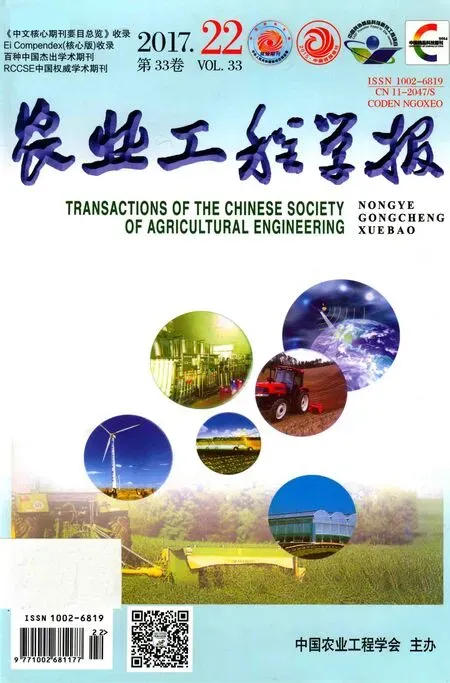叶片前缘磨损形貌特征对风力机翼型气动性能的影响
李德顺,王成泽,李银然,李仁年,赵振希,陈 霞
叶片前缘磨损形貌特征对风力机翼型气动性能的影响
李德顺1,2,3,王成泽1,4,李银然1,2,3,李仁年1,2,3,赵振希1,陈 霞1
(1. 兰州理工大学能源与动力工程学院,兰州 730050; 2. 甘肃省风力机工程技术研究中心,兰州 730050; 3. 甘肃省流体机械及系统重点实验室,兰州 730050; 4. 湘电风能有限公司,湘潭 411101)
根据实际风电场中风力机叶片前缘磨损在不同阶段的形貌特征,通过对DU 96-W-180风力机翼型前缘进行改型,建立几何模型,结合SST湍流模型求解RANS方程,分析了翼型的升力、阻力及流场特性,研究了风力机翼型前缘磨损形貌特征对其气动性能的影响。结果表明,前缘磨损特征为砂眼和小坑时,对翼型的升、阻力系数影响较小;而前缘磨损特征为脱层时,对翼型的升阻特性影响显著,尤其随着攻角增加,升力系数大幅减小,阻力系数急剧增大,并且随着磨损的加剧,减小和增加的幅度逐渐增大。前缘磨损加剧了翼型吸力面尾缘附近的流动分离,使分离点前移;砂眼和小坑对气流在翼型前缘的流动影响较小;脱层对翼型前缘附近流动影响很大,导致翼型表面出现台阶流,气流绕过台阶先发生分离,然后再次附着翼型表面流动。
风能;风力机;磨损;翼型;前缘磨损特征;气动性能;数值模拟
0 引 言
风力机常运行在恶劣的自然环境下,无法避免沙粒、雨滴、冰雹和昆虫等颗粒物对叶片表面的冲刷,导致叶片表面发生磨损,前缘磨损尤其严重[1-2]。随着风力机运行时间的增长,叶片前缘磨损越来越严重,表面粗糙度也逐渐增大。针对叶片表面粗糙度和前缘磨损的研究表明,叶片前缘粗糙度对其气动性能影响显著,使其气动性能下降明显[3-4];随着前缘粗糙度的增大,翼型升力系数明显下降,阻力系数大幅增加[5-6],同时,风力机输出功率显著下降,下降幅度可达到25%[7],影响了机组正常发电。
Sareen等[8]通过风洞试验研究了前缘磨损对风力机叶片气动性能的影响,结果表明,前缘磨损对翼型的气动性能产生严重的影响,导致翼型的升力下降、阻力上升,随着前缘磨损的加剧,阻力增加可高达6%~500%。Gaudern等[9]开展了风洞试验,通过对不同厚度翼型的实际粗糙度大小进行缩放来模拟多种磨损深度,研究了磨损对翼型气动性能的影响。Kidder等[10-11]研究了前缘保护带对翼型气动特性的影响。Gharali和Johnson[12]采用数值模拟的方法研究了S809翼型的前缘磨损问题,发现升力系数减小的主要影响因素为磨损的宽度而非磨损的深度。张骏等[13]采用数值模拟方法研究了风力机二维翼型和三维叶片表面粗糙度对其气动性能的影响,结果表明,翼型气动性能受到翼型表面粗糙度,尤其是前缘粗糙度的影响非常严重,并且随着攻角的增大,气动性能对前缘粗糙度的敏感性增大;三维叶片的表面粗糙度使得叶片气动性能明显下降,叶尖部位的粗糙度影响尤为显著。焦灵燕[14]研究了叶片气动性能随着粗糙度的变化规律,粗糙度增大使得翼型阻力增大,升力降低,升阻比减小,翼型尾缘处布置粗糙带可以使翼型的流动分离点前移。Ren等[15]基于二维N-S方程和SST湍流模型对NACA 63-430翼型的气动特性进行了数值模拟,结果表明,粗糙度加剧了层流向湍流的过渡和流动分离。Keegan等[16-19]建立了雨和冰雹的动态模型,并使用LS-DYNA软件模拟了冰雹对于前缘的影响。Zhang等[20]通过试验方法研究了雨滴侵蚀磨损过程中的影响因素,研究发现雨滴冲击叶片表面的相对速度和冲击的频率是影响磨损率的最主要因素。蒋传鸿[21]采用RFOIL软件和CFD方法,对比分析了光冰和霜冰对翼型气动性能的影响,结果表明,霜冰导致升力系数变化不大,在一定的攻角范围内,升阻比略有下降;光冰对翼型的气动性能影响显著,使其升力系数减小,阻力系数增大,升阻比大幅度降低。李长仁等[22]研究了风力机叶片表面污染对其气动性能的影响,研究结果表明,表面污染会使叶片气动性能下降,其升力系数最大可下降35%。Dalili等[23-24]论述了叶片表面工程问题对风力发电机的重要性,当风力机叶片表面的完整性受到损害时,其性能会发生显著的降低,功率损失最高可达到50%。新疆大学余冬、张永等对风力机叶片涂层材料的冲蚀磨损进行了大量的研究[25-29]。
总体来看,上述相关文献主要针对叶片表面结冰和灰尘、昆虫颗粒吸附在叶片表面等情况下引起的前缘粗糙度对翼型气动性能的影响开展了研究,然而,针对由于叶片磨损而导致的前缘形貌改变(即叶片前缘部分材料磨损脱落)对风力机翼型气动性能影响的研究较少。
本文结合实际风场中运行的风力机叶片前缘磨损的形貌特征,通过对DU 96-W-180风力机翼型的前缘进行改型建立几何模型,以模拟风力机叶片不同磨损阶段的前缘磨损形貌特征,基于CFD方法对翼型的空气动力特性进行数值模拟,通过将不同磨损特征时翼型的气动特性和光滑翼型的气动特性进行对比,研究了前缘磨损形貌特征对风力机翼型气动特性的影响。
1 模型及数值方法
1.1 研究对象和前缘磨损几何模型
研究对象为DU 96-W-180翼型,该翼型由荷兰Delft大学设计,常用于风力机叶片的叶尖部分,其相对厚度为18%[30]。为了与文献[8]中的风洞试验结果进行对比,本文选用的翼型弦长与试验模型的弦长一致为0.457 m。DU 96-W-180翼型的几何外形如图1所示。

图1 DU 96-W-180翼型
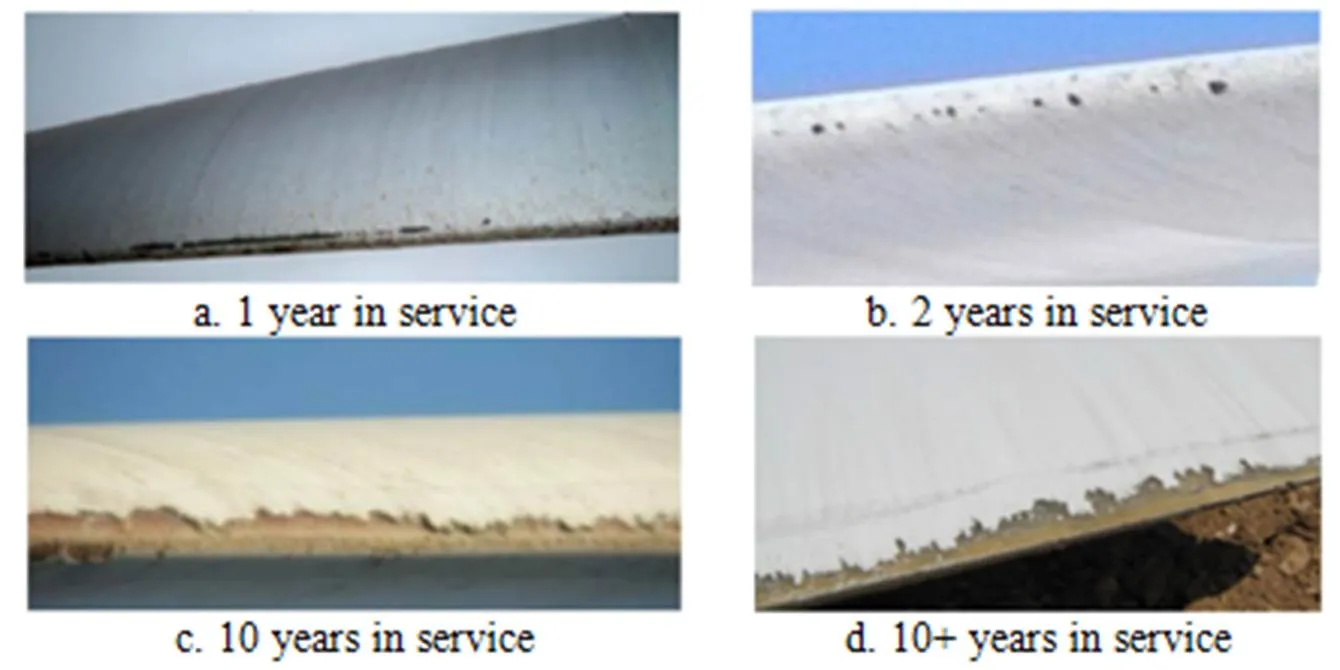
图2 叶片磨损图
根据3M公司提供的分别运行了1、2、10 a及10 a以上叶片的磨损图片(如图2所示)可知,运行了1 a的叶片,在各种复杂颗粒撞击下,叶片前缘最先出现细小的砂眼,运行2 a后,砂眼很快发展成尺寸更大、深度更深的小坑,如果任其发展下去,随着砂眼和小坑数量的增多,最终导致前缘材料大面积脱落,称之为脱层现象。脱层现象首先出现在叶片前缘,随着时间的推移,它将沿着弦线方向逐渐扩大。最先出现磨损(也是磨损最严重)的部位在叶片前缘,随后叶片压力面靠近前缘部分逐渐出现磨损,磨损区域随着时间的推移向叶片尾缘扩展。
通过对不同阶段磨损图片的分析,将叶片前缘磨损形貌特征定义为3种形式:砂眼、小坑和脱层。基于3M公司提供的叶片磨损特征,得到砂眼、小坑、脱层的尺寸及其在翼型前缘的覆盖范围,如表1所示[8]。砂眼、小坑、脱层的深度分别取0.51、2.54、3.81 mm,并且砂眼和小坑的平均直径和深度的大小相等,前缘覆盖范围表示磨损特征从前缘开始沿弦向的分布范围。根据磨损发展的过程,用3种磨损类型来描述磨损的过程,分别是Type A(只有砂眼的磨损情况),Type B(既有砂眼又有小坑的磨损情况)和Type C(有砂眼、小坑以及脱层的磨损情况),每种磨损类型都分为3个不同的磨损阶段,下一阶段的砂眼、小坑的数目和脱层的覆盖范围是前一阶段的两倍;由于压力面前缘磨损程度和磨损覆盖范围都要大于吸力面,因此取压力面上砂眼、小坑数量为吸力面数目的两倍,具体见表2。
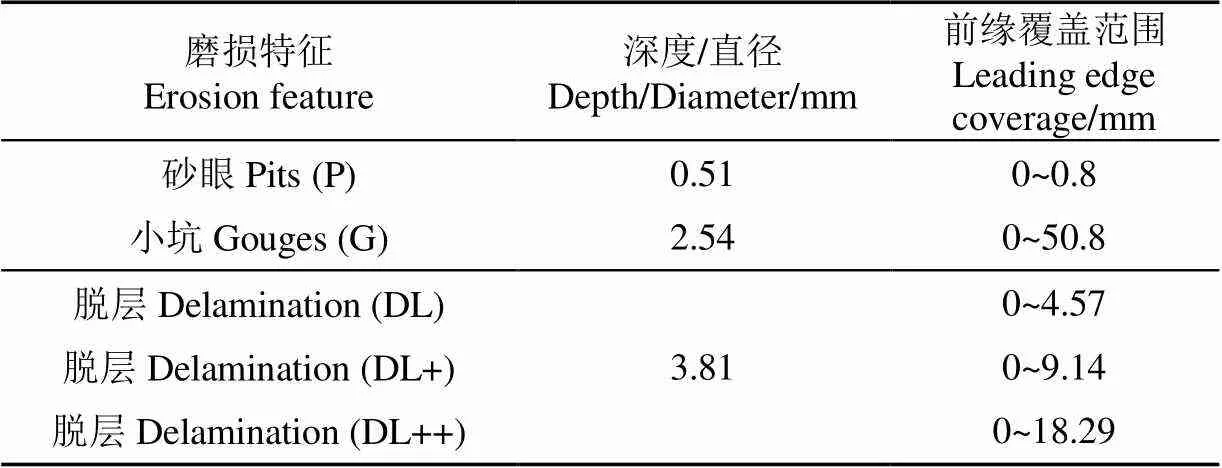
表1 不同磨损特征的尺寸
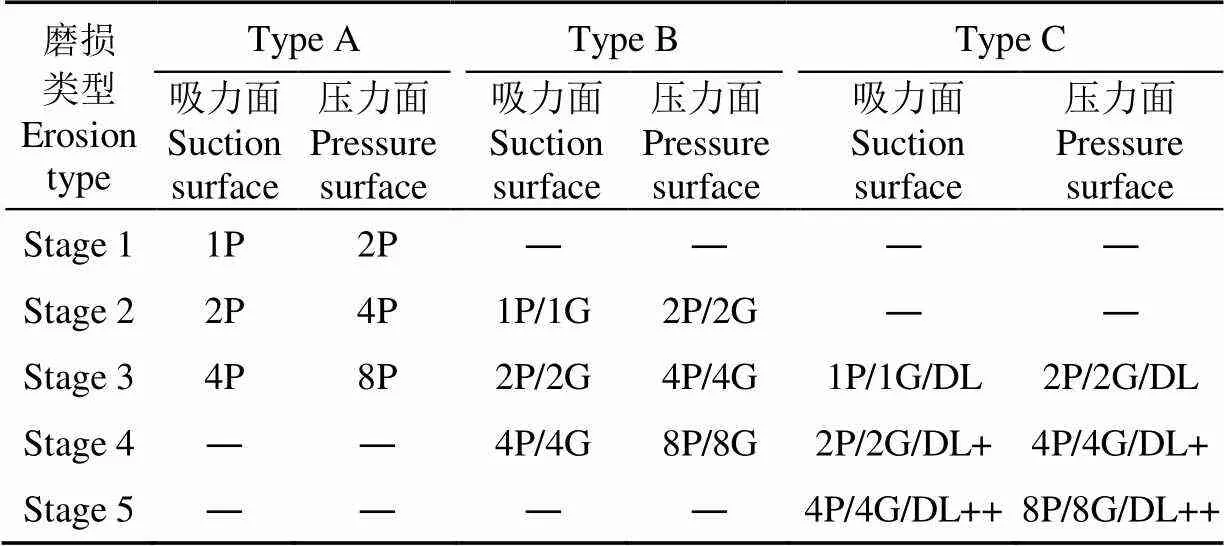
表2 不同磨损程度时的磨损特征分布
注:P为砂眼,G为小坑,DL为脱层,下同。
Note: P means pits, G means gouges, DL means delamination. Same as below.
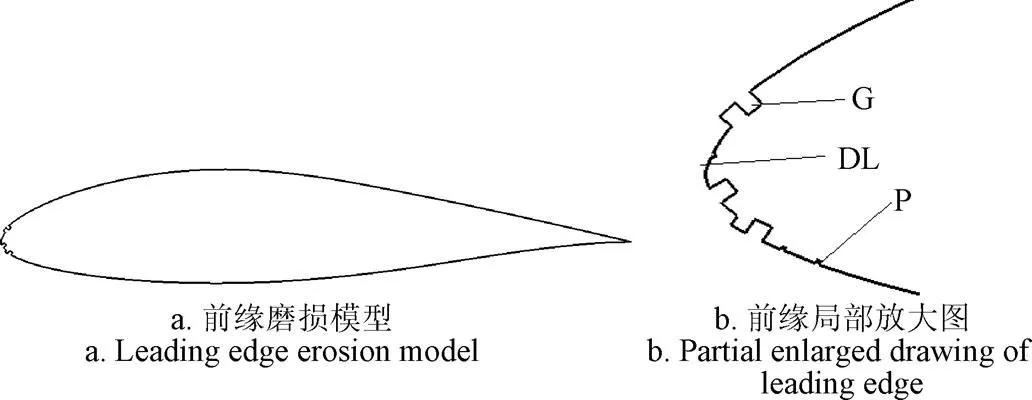
图3 C3前缘磨损模型
表2列出了各磨损阶段时,翼型压力面和吸力面上砂眼、小坑的数目和脱层的覆盖范围。表中从左往右表示磨损程度逐渐加剧;从上往下表示同一种磨损特征时,磨损越来越严重。表中的数字表示砂眼和小坑的数目,比如Type C Stage 3(简写为C3)磨损程度为翼型吸力面有1个砂眼(1P)和1个小坑(1G),压力面有2个砂眼(2P)和2个小坑(2G),前缘有轻微的脱层(DL),如图3所示。每种磨损类型均在雷诺数为1×106时进行数值模拟。
1.2 计算域及网格划分
计算域如图4所示,半圆形入口距尾缘处为12.5倍的弦长,尾缘距出口为15倍的弦长(),计算域网格划分采用C型结构化网格。
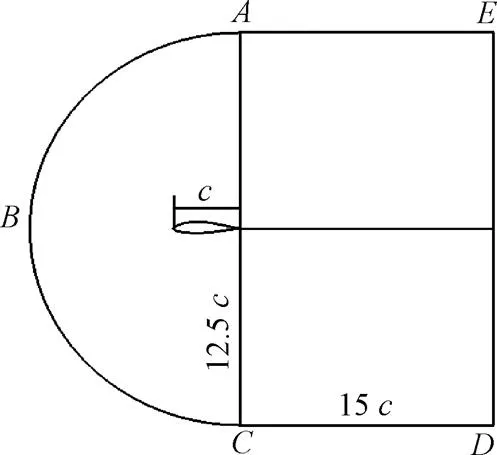
注:c为弦长。
流体绕流的数值模拟精度跟网格节点分布密切相关,且翼型附近流体速度和压力的变化梯度远大于远场相关参数变化梯度,因此,对翼型表面和周围网格进行适当加密,翼型周向分布913个节点,边界层第1层高度为0.02 mm。翼型周围网格如图5所示。
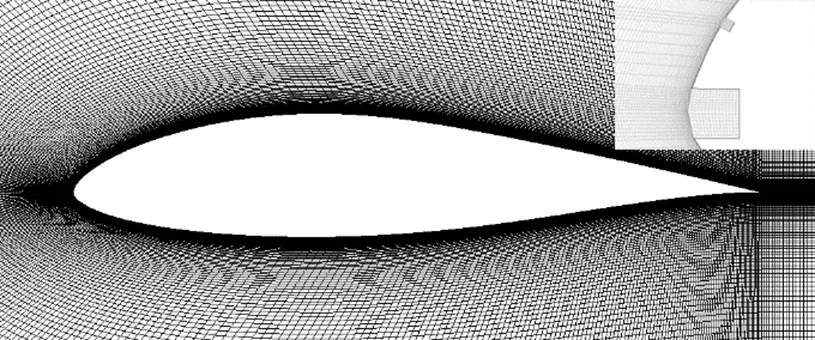
图5 翼型周围网格
1.3 数学模型
冲蚀磨损使得翼型表面凹凸不平,在翼型的气动外形受到破坏的同时也增大了翼型表面粗糙度。翼型外形的改变,造成气流在翼型近壁面的流动发生变化,为了更加精确地捕捉气流绕磨损区域的流动状态,本文采用SST湍流模型封闭二维不可压缩RANS方程,求解湍流流动,研究前缘磨损对翼型气动性能的影响。该湍流模型在近壁面采用湍流模型,用来精准地捕捉黏性底层流动,同时,为了克服湍流模型对来流的敏感性,主流区采用湍流模型。
1.4 边界条件
入口边界条件为速度进口,为图4所示半圆形边界,当攻角为正值时,边界为速度进口边界,攻角为负值时,边界AE为速度进口,攻角为0时,边界、同时设为速度入口,其中速度大小为23.084 m/s(雷诺数为1×106),湍流强度为0.05,湍流黏度比为10。
出口边界条件为压力出口,为图4所示边界,表压为0,当来流为正攻角,边界为压力出口,若来流为负攻角,边界为压力出口。
壁面边界采用无滑移固体壁面边界条件。
2 计算方法及可靠性验证
对DU 96-W-180翼型进行数值模拟时,离散方法采用二阶迎风格式,压力和速度的耦合采用SIMPLEC算法。图6为光滑DU 96-W-180翼型升、阻力系数随攻角变化的试验值和数值模拟结果对比图,图中的试验值是由Sareen等[8]在伊利诺斯大学香槟分校的低湍流亚音速风洞中测试得到,矩形测试段截面尺寸为0.853 m×1.219 m,长为2.438 m,试验段风速可达71.53 m/s,分别在为1×106,1.5×106,1.85×1063种工况下,开展了DU 96-W-180翼型的风洞试验,试验模型弦长为0.457 m(与本文几何模型的弦长一致),通过测量翼型所受的法向力和轴向力,进而计算出翼型的升力系数和阻力系数,具体见文献。由图可知,翼型升、阻力系数的数值计算结果与风洞试验值吻合良好,−5.3°~10.3°攻角范围内,升力系数的最大误差为7%,故本文采用的数值方法可靠。
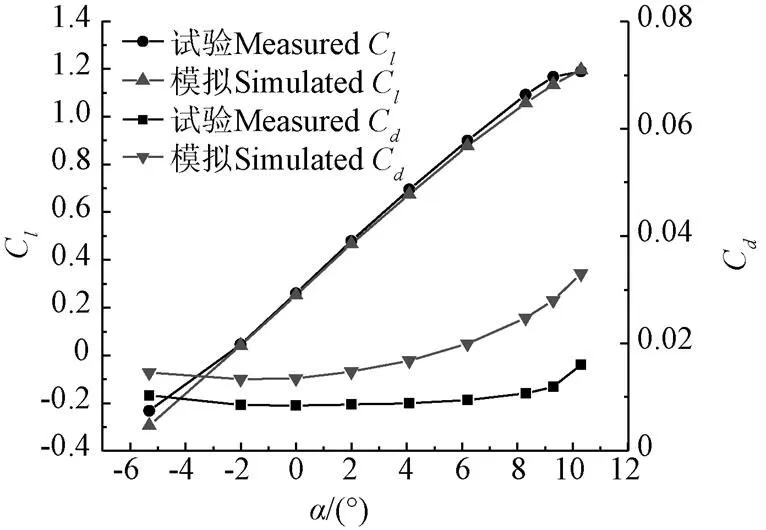
注:Cl为升力系数,Cd为阻力系数,α为攻角。
3 结果与分析
3.1 升力和阻力特性分析
图7分别是翼型在Type A、B、C 3种磨损类型时的升、阻力系数和升阻比随攻角的变化曲线与光滑翼型的升、阻力曲线和升阻比曲线的对比图。
由图7a可知,磨损类型为Type A时,随着砂眼数目的增多,翼型的升力、阻力系数和升阻比基本不变,磨损翼型的阻力系数较光滑翼型略有增大。在−5.3°~0°攻角范围内,磨损翼型的升力系数和升阻比与光滑翼型的几乎相同。当攻角大于0°后,其升力系数和升阻比较光滑翼型的值均有所下降,并且随着攻角的增大,下降幅度增大。在攻角为10.3°时,3种磨损程度时磨损翼型的升力系数较光滑翼型的值均减小了2.7%左右,升阻比下降6%。
由图7b可知,磨损类型为Type B时,升、阻力系数变化规律跟磨损类型为Type A时相似,当攻角大于0°时,随着磨损阶段从B2到B4,升力系数减小和阻力系数增大的幅度逐渐增大。3种磨损程度时,翼型的升阻比与光滑翼型相比下降比较明显。同时,随着磨损的加剧(从B2到B4),翼型升阻比略有下降。当攻角为10.3°时,翼型在3种磨损程度时对应的升力系数较光滑翼型均减少了5.8%左右,对应升阻比均减小10%左右。
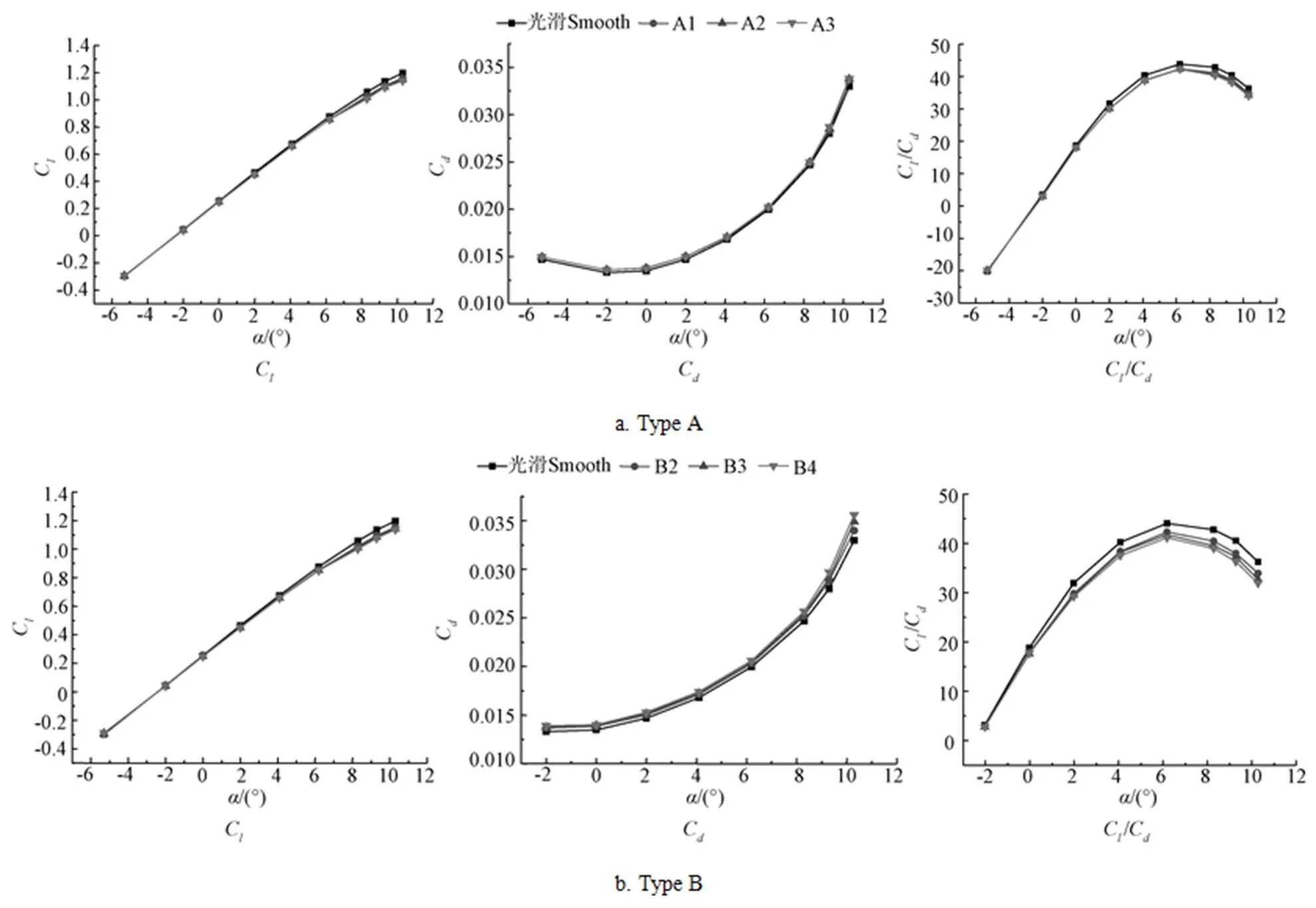
注:A1-A3、B2-B4、C3-C4分别对应表2中的Type A、B、C的3个磨损阶段。
Note: A1-A3, B2-B4, C3-C4 were the three erosion stages of Type A, B, C in table 2, respectively.
图7 升力、阻力及升阻比曲线
Fig.7 Curves of lift, drag and lift-drag ratio
由图7c可知,磨损类型为Type C时,当攻角在0°附近时,升力系数相比于光滑翼型的变化很小,随着攻角增大,升力系数降低,阻力系数增加,而且攻角越大,升、阻力系数变化越明显。当攻角大于−2°时,3种磨损程度时对应的升阻比与光滑翼型的相比均有所减小,且攻角越大减小越明显,随着磨损程度加剧(从C3到C5),升力系数略有下降,阻力系数增大越明显,升阻比减小也更加显著。当攻角为10.3°时,翼型在3种磨损程度时的升力系数均减少了14.3%左右,升阻比减小60%左右。
综上所述,表面磨损特征为砂眼和小坑时,对翼型气动性能影响较小;当磨损导致叶片前缘出现脱层后,翼型的升力系数显著减小,阻力系数急剧增大,翼型气动性能显著下降。
3.2 流动特性分析
图8为攻角为9.3°时磨损翼型和光滑翼型周围的流线图,对比发现,前缘磨损加剧了吸力面尾缘附近的流动分离,使得流动分离点前移,并且随着磨损从Type A到Type C逐渐加深,边界层分离点向前缘靠近,分离现象越来越显著,分离后形成的漩涡区逐渐变大,导致翼型的升力降低和阻力增加。

图8 攻角为9.3°时光滑翼型与磨损翼型的流场对比图
翼型前缘受到颗粒物的撞击,表面部分材料被磨损而脱落,造成翼型的几何外形发生改变,对气流绕翼型的流动产生影响。图9是攻角为9.3°时气流绕光滑翼型和磨损翼型前缘流线图,比较磨损翼型和光滑翼型前缘流动发现,前缘发生磨损为砂眼和小坑时,对边界层流动影响非常小,在黏性力的作用下砂眼和小坑内的气流呈无限循环的漩涡状,该漩涡对边界层没有太大的影响,由于砂眼和小坑的尺寸对翼型外形的影响很小,使得气流流过Type A、Type B磨损类型的翼型时几乎和光滑翼型的流动情况相同,如图9b、c所示,因此,对翼型的气动性能的影响较小。当前缘磨损加重,出现脱层时,脱层边界处形成明显的台阶,改变了翼型前缘附近流动状态,气流绕过脱层台阶后出现边界层流动分离,如图9d所示,气流流过吸力面和压力面台阶的流动分离如图9e、f所示,在台阶前后都形成了漩涡,气流在流过台阶后先发生分离然后又重新附着在翼型表面流动;结合图8d可知,前缘脱层导致翼型表面同时发生了前缘分离和后缘分离现象,使得翼型的升力减小,阻力急剧上升,升阻比显著下降。
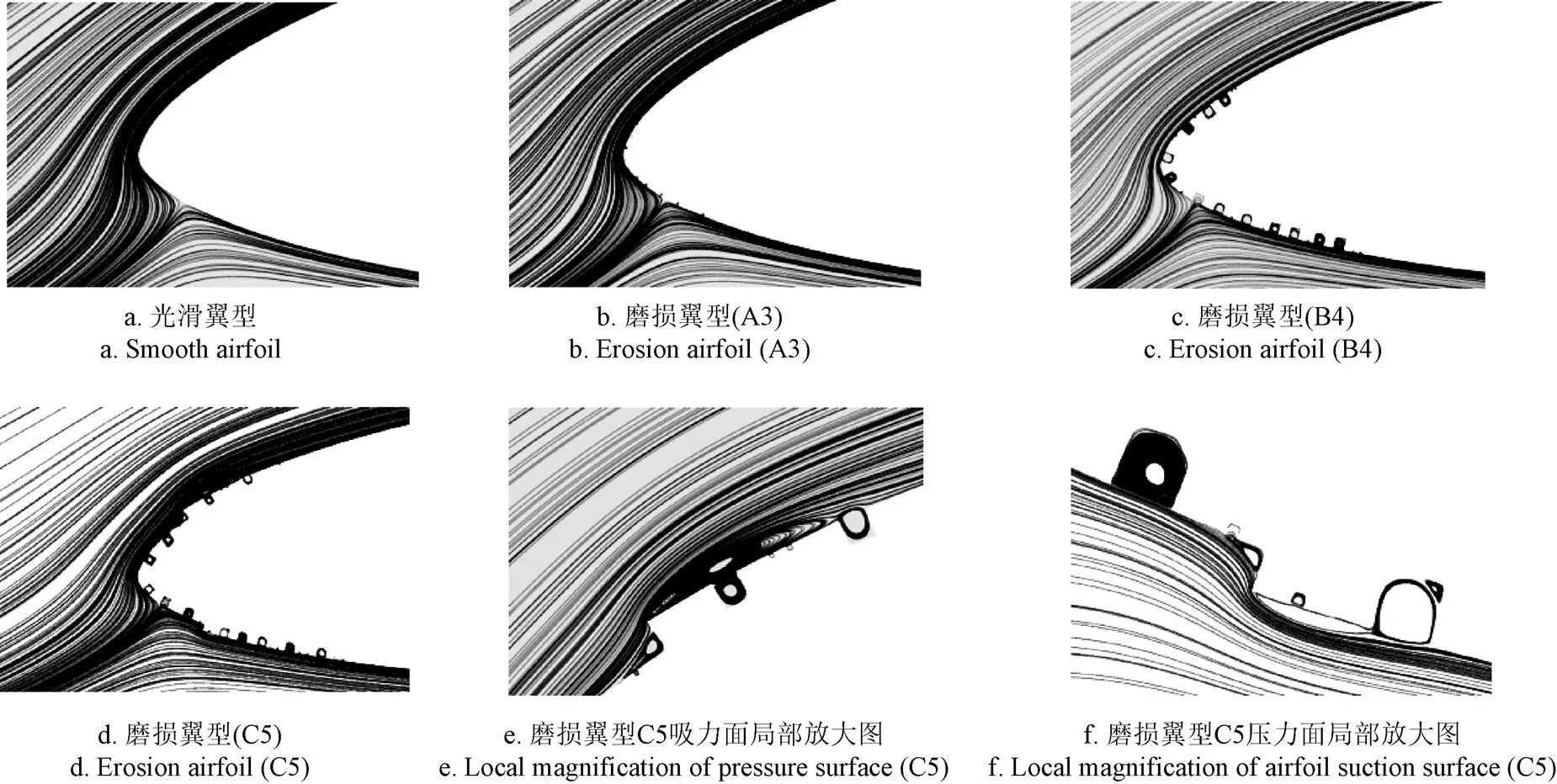
图9 攻角为9.3°时光滑翼型与磨损翼型前缘流动对比
4 结 论
本文基于CFD方法,研究了风力机翼型在3种磨损特征时,其升力系数、阻力系数、升阻比的变化规律,以及流动特性。结论如下:
1)砂眼和小坑对翼型的升、阻力系数影响较小,当攻角小于0°时,磨损翼型的升力系数跟光滑翼型的几乎相等,随着攻角增大,升力系数略有减小,阻力系数有小幅增加,升阻比略有下降,当攻角为10.3°时,磨损翼型的升阻比较光滑翼型值减少10%左右。
2)前缘脱层对翼型升、阻力系数和升阻比的影响显著,尤其在大攻角时,升力系数大幅降低,阻力系数急剧增加,升阻比下降明显,当攻角为10.3°时,磨损翼型的升阻比较光滑翼型值的减小量可高达60%;随着磨损程度加剧,升力系数减小和阻力系数增加的幅度逐渐增大。
3)前缘磨损加剧了翼型吸力面尾缘附近的流动分离,使分离点前移;砂眼和小坑对气流在翼型前缘的流动影响较小;脱层对翼型前缘附近流动影响较大,脱层导致翼型表面出现台阶流,气流绕过台阶先发生分离,然后再次附着于翼型表面流动。
[1] Slot H M, Gelinck E R M, Rentrop C, et al. Leading edge erosion of coated wind turbine blades: Review of coating life models[J]. Renewable Energy, 2015, 80: 837-848.
[2] Keegan M H, Nash D H, Stack M M. On erosion issues associated with the leading edge of wind turbine blades[J]. Journal of Physics D Applied Physics, 2013, 46(38): 383001.
[3] Khalfallah M G, Koliub A M. Effect of dust on the performance of wind turbines[J]. Desalination, 2007, 209(1): 209-220.
[4] Soltani M R, Birjandi A H, Moorani M S. Effect of surface contamination on the performance of a section of a wind turbine blade[J]. Scientia Iranica, 2011(3): 349-357.
[5] 李德顺,李仁年,杨从新,等. 粗糙度对风力机翼型气动性能影响的数值预测[J]. 农业机械学报,2011,42(5):111-115.
Li Deshun, Li Rennian, Yang Congxin, et al. Numerical prediction of the effect of surface roughness on aerodynamic performance of a wind turbine airfoil[J]. Transactions of the Chinese Society for Agricultural Machinery, 2011, 42(5): 111-115.
[6] 李仁年,陈寅. 雷诺数对粗糙表面翼型气动性能的影响[J]. 南京航空航天大学学报,2011,43(5):693-696.
Li Rennian, Chen Yin. Effects of surface roughness and reynolds number on aerodynamic performance of wind turbine airfoil[J]. Journal of Nanjing University of Aeronautics & Astronautics, 2011, 43(5): 693-696. (in Chinese with English abstract)
[7] Madsen H A. Aerodynamics of a horizontal-axis wind turbine in natural conditions[R]. Risø National Laboratory for Sustainable Energy, Technical University of Denmark, 1991.
[8] Sareen A, Sapre C A, Selig M S. Effects of leading edge erosion on wind turbine blade performance[J]. Wind Energy, 2014(17): 1531-1542.
[9] Gaudern N. A practical study of the aerodynamic impact of wind turbine blade leading edge erosion[J]. Journal of Physics: Conference Series, 2014, 524(1): 012-031.
[10] Kidder N. Aerodynamic Impact of Leading Edge Surface Treatments on Wind Turbine Blades[D]. Columbus: The Ohio State University, 2015.
[11] AgrimSareen, Chinmay A Sapre, Michael S Selig. Effects of leading-edge protection tape on wind turbine blade performance[J]. Wind Engineering, 2012, 36(5): 525-534.
[12] Gharali K, Johnson D A. Numerical modeling of an S809 airfoil under dynamic stall, erosion and high reduced frequencies[J]. Applied Energy, 2012, 93: 45-52.
[13] 张骏,袁奇,吴聪,等. 大型风力机叶片表面粗糙度效应数值研究[J]. 中国电机工程学报,2014,20:3384-3391.
Zhang Jun, Yuan Qi, Wu Cong, et al. Numerical simulation on the effect of surface roughness for large wind turbine blades[J]. Proceedings of the CSEE, 2014, 20: 3384-3391. (in Chinese with English abstract)
[14] 焦灵燕. 翼型及粗糙度对风力机叶片气动性能影响的初探[D]. 呼和浩特:内蒙古工业大学,2015.
Jiao Lingyan. Investigation on Influence of Airfoils and Roughness on Wind Turbine Aerodynamic Performance of Blade[D]. Huhhot: Inner Mongolia University of Technology, 2015. (in Chinese with English abstract)
[15] Ren Nianxin, Ou J. Dust effect on the performance of wind turbine airfoils[J]. Journal of Electromagnetic Analysis and Applications, 2009, 1(1): 102-107.
[16] Keegan M H, Nash D H, Stack M M. Numerical modelling of hailstone impact on the leading edge of a wind turbine blade[J]. Ewea, 2013, 4(6): 498-502.
[17] Keegan M H, Nash D H, Stack M M. Modelling rain drop impact of offshore wind turbine blades[J]. ASME Turbo Expo, 2012. 2012, 31(1): 887-898, Copenhagen.
[18] Keegan M H, Nash D, Stack M. Modelling rain drop impact of offshore wind turbine blades[J]. ASME Turbo Expo, 2012, 2012: Article GT 2012-69175.
[19] Keegan M H, Nash D, Stack M. Numerical modelling of hailstone impact on the leading edge of a wind turbine blade[J]. EWEA Annual Wind Energy Event, Transactions of the ASME, 2005, 127: 464-474.
[20] Zhang S, Dam-Johansen K, Nørkjær S, et al. Erosion of wind turbine blade coatings: Design and analysis of jet-based laboratory equipment for performance evaluation[J]. Progress in Organic Coatings, 2015, 78: 103-115.
[21] 蒋传鸿. 风力机结冰翼型的气动性能分析及优化设计[D].重庆:重庆大学,2014.
Jiang Chuanhong. Aerodynamic Performance Analysis and Optimization Design of Wind Turbine with Iced Airfoil[D]. Chongqing: Chongqing University, 2014. (in Chinese with English abstract)
[22] 李长仁,李国文,陈薇. 风力机叶片前缘表面附着物对气动性能的影响研究[J]. 太阳能学报,2012, 33(4):540-544.
Li Changren, Li Guowen, Chen Wei. Effect of attachment of blade surface on wind turbine[J]. Acta Energiae Solaris Sinica, 2012, 33(4): 540-544. (in Chinese with English abstract)
[23] Dalili N, Edrisy A, Carriveau R. A review of surface engineering issues critical to wind turbine performance[J]. Renewable and Sustainable Energy Reviews, 2009, 13(2): 428-438.
[24] Slot H M, Gelinck E R M, Rentropa C, et al. Leading edge erosion of coated wind turbine blades: Review of coating life models[J]. Renewable Energy, 2015, 80: 837-848.
[25] 余冬. 风机叶片复合材料冲刷磨损研究[D]. 乌鲁木齐:新疆大学,2014.
Yu Dong. The Study about Composite Materialerosion Wear of Wind Turbine Blade[D]. Urumchi: Xinjiang University. 2014. (in Chinese with English abstract)
[26] 余冬,李新梅,于青,等. 风力发电机叶片复合材料的冲刷磨损[J]. 材料热处理学报,2014, 35(4):166-170.
Yu Dong, Li Xinmei, Yu Qing, et al. Erosion corrosion of wind turbine blade composite material[J]. Transactions of Materials and Heat Treatment, 2014, 35(4): 166-170. (in Chinese with English abstract)
[27] 董晓锋. 气固两相流下风力发电机叶片材料冲刷磨损行为研究[D]. 乌鲁木齐:新疆大学,2013.
Dong Xiaofeng. Gas-solid Flow Erosion Wear Behavior of Key Materials of the Wind Turbine[D]. Urumchi: Xinjiang University, 2013. (in Chinese with English abstract)
[28] 张永,刘召,黄超,等. 挟沙风作用下风力机叶片涂层冲蚀磨损研究进展[J]. 新能源进展,2015,5(4):331-335.
Zhang Yong, Liu Zhao, Huang Chao, et al. Research process on erosion wear of wind turbine blade coating by wind-borne sands[J]. Advances in New and Renewable Energy, 2015, 5(4): 331-335. (in Chinese with English abstract)
[29] 董旭旭,李新梅,董兰兰,等. 风力机叶片用复合材料的拉伸及冲蚀磨损性能[J]. 机械工程材料,2015,12:25-29.
Dong Xuxu, Li Xinmei, Dong Lanlan, et al. Tensile and erosion-wear properties of composite material for wind turbine blade[J]. Materials for Mechanical Engineering, 2015, 12: 25-29. (in Chinese with English abstract)
[30] Timmer W A, Rooij R PJ O M. Summary of the Delft University wind turbine dedicated airfoils[J]. ASME Journal of Solar Energy Engineering, 2003, 125(4): 488-496.
李德顺,王成泽,李银然,李仁年,赵振希,陈 霞. 叶片前缘磨损形貌特征对风力机翼型气动性能的影响[J]. 农业工程学报,2017,33(22):269-275. doi:10.11975/j.issn.1002-6819.2017.22.035 http://www.tcsae.org
Li Deshun, Wang Chengze, Li Yinran, Li Rennian, Zhao Zhenxi, Chen Xia. Influence of blade leading edge erosion features on aerodynamic characteristics of wind turbine airfoil[J]. Transactions of the Chinese Society of Agricultural Engineering (Transactions of the CSAE), 2017, 33(22): 269-275. (in Chinese with English abstract) doi:10.11975/j.issn.1002-6819.2017.22.035 http://www.tcsae.org
Influence of blade leading edge erosion features on aerodynamic characteristics of wind turbine airfoil
Li Deshun1,2,3, Wang Chengze1,4, Li Yinran1,2,3, Li Rennian1,2,3, Zhao Zhenxi1, Chen Xia1
(1.730050,; 2.730050; 3.730050; 4.411101,)
Because wind turbine blades are exposed to complex natural environment for a long time, as time goes on, rain, snow, dust and other particles will gradually erode the surface of blade, then causing the erosion on the blade surface, especially at the leading edge of the blades, which is the area with the most serious wear. With wind turbine running time increasing, under the impact of various complex particles, the erosion process on wind turbine blades typically starts with the formation of small pits at the leading edge, which quickly develop into gouges with larger size and deeper depth, and then the increasing pits and gouges eventually lead to the fact that material of the leading edge falls off largely, forming delamination. In order to simulate the leading edge erosion of wind turbine as accurately as possible, a geometric model which is close to the actual wear profile was established and a mathematical model which is suitable for airfoil calculation was selected. According to the erosion features on leading edge of wind turbine blade operating in actual wind farm, the leading edge of DU96-W-180 airfoil profile was modified to study the effects of aerodynamic characteristics caused by leading edge erosion on wind turbine blades. At the same time, a geometric model was built and numerical simulations were performed to solve the RANS equation based on SSTturbulence model. Lift force, drag force and flow field characteristics of the erosion airfoil were analyzed. And then the conclusions were drawn. In the situation that leading edge erosion is characterized by pits and gouges, the coefficients of lift and drag have a small change, and as the attack angle increases, the lift coefficient and lift-drag ratio decrease slightly, and the drag coefficient increases slightly. The influence of leading edge delamination is notable, especially under the situation of high attack angle, and the lift coefficient and lift-drag ratio are significantly reduced and the drag coefficient is sharply enlarged with the increase of the attack angle, and this change becomes more notable with the increase of erosion. The leading edge erosion intensifies the flow separation near the trailing edge of the airfoil suction surface, and makes the separation point move forward. The phenomenon of separation is more and more obvious as the degree of wear and tearing is gradually deepening, and the eddy forms after separation gradually becomes larger, resulting in the fact that lift reduces and resistance increases. Pits and gouges have small influence on the flow near the airfoil leading edge. On the contrary, delamination leads to the step-flow around the airfoil surface, and air bypasses the step with separating flow, and then adheres to the airfoil surface again, so the delamination has a significant impact on the flow near the leading edge, which leads to the deterioration of airfoil aerodynamic performance.
wind energy; wind turbines; erosion; airfoil; leading edge erosion feature; aerodynamic characteristics; numerical simulation
10.11975/j.issn.1002-6819.2017.22.035
TK83
A
1002-6819(2017)-22-0269-07
2017-06-02
2017-11-07
国家重点基础研究发展计划(973计划)(2014CB046201);国家自然科学基金项目(51766009、51566011)。
李德顺,男(汉族),甘肃甘谷人,副教授,博士,主要从事风能利用方向的研究。Email:lideshun_8510@sina.com

